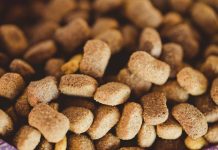Welcoming a new puppy into your home is a joyous occasion filled with playful antics, wagging tails, and boundless energy. As a pet parent, one of your most important responsibilities is ensuring your furry friend grows up healthy and strong. Just like human babies, puppies require a balanced diet to support their developing muscles and joints, laying the foundation for a lifetime of vitality and happiness. In this guide, we’ll explore the best puppy foods specifically formulated to nourish growing bodies, ensuring your little companion gets all the nutrients they need. From understanding key ingredients to selecting the right formula for your breed, we aim to equip you with the knowledge to make informed choices that will support your puppy’s health and well-being. Let’s embark on this journey together to give your puppy the best start in life.
Understanding Your Puppys Nutritional Needs for Muscle and Joint Development
Ensuring your puppy receives the right nutrients is essential for their healthy muscle and joint development. During these formative months, a diet rich in specific components can make all the difference. Focus on foods that include high-quality proteins, which are crucial for building and repairing muscle tissue. Look for ingredients such as chicken, lamb, or fish, as these not only support muscle growth but also provide essential amino acids.
Moreover, it’s important to incorporate essential fatty acids like Omega-3 and Omega-6, which play a vital role in maintaining joint health and reducing inflammation. Key sources include fish oil and flaxseed. Consider foods that are fortified with calcium and phosphorus, as these minerals are critical for developing strong bones. Also, keep an eye out for glucosamine and chondroitin, which are known to support joint cartilage and help prevent future issues. Some recommended nutrients to look for in your puppy’s diet include:
- High-quality proteins: Chicken, lamb, fish
- Essential fatty acids: Omega-3 and Omega-6 from fish oil, flaxseed
- Minerals: Calcium and phosphorus for bone strength
- Joint support: Glucosamine and chondroitin
By choosing the right food, you’re setting the foundation for a lifetime of healthy mobility and strength for your furry friend. Tailoring your puppy’s diet to include these nutrients will ensure they grow into strong, agile, and healthy dogs.

Key Ingredients to Look for in Puppy Food for Optimal Growth
When choosing food for your puppy, it’s crucial to focus on ingredients that promote healthy development. High-quality protein sources such as chicken, turkey, or fish are essential for building strong muscles. These proteins provide the necessary amino acids that are the building blocks for muscle tissue, supporting your puppy’s active lifestyle.
Look for foods enriched with omega-3 fatty acids, like DHA, which are vital for brain and vision development. Calcium and phosphorus should also be present in balanced proportions to ensure healthy bone growth. Glucosamine and chondroitin are beneficial for joint health, particularly in larger breeds. Additionally, ensure the presence of antioxidants and vitamins, such as E and C, which help boost the immune system, keeping your puppy vibrant and healthy.
- High-quality protein sources
- Omega-3 fatty acids
- Calcium and phosphorus
- Glucosamine and chondroitin
- Antioxidants and vitamins

Top Recommended Puppy Foods for Strong Muscles and Healthy Joints
Choosing the right food for your puppy is crucial to ensure they develop strong muscles and maintain healthy joints as they grow. It’s essential to select a diet that provides the right balance of proteins, fats, and nutrients. Here are some top recommendations:
- High-Protein Formulas: Look for foods with a high percentage of quality proteins such as chicken, beef, or fish. Proteins are the building blocks for muscle development and are essential for active puppies.
- Omega-3 and Omega-6 Fatty Acids: These essential fatty acids support joint health and can be found in ingredients like fish oil and flaxseed. They help reduce inflammation and promote a shiny coat.
- Glucosamine and Chondroitin: These supplements are often added to puppy foods to support joint health and are especially beneficial for larger breeds prone to joint issues.
- Calcium and Phosphorus: Balanced levels of these minerals are vital for bone growth and strength, ensuring your puppy’s skeletal structure develops properly.
By incorporating these elements into your puppy’s diet, you’ll be setting them up for a lifetime of health and vitality. Always consult with your veterinarian to tailor the best nutritional plan for your furry friend’s specific needs.

Tips for Transitioning Your Puppy to a New Diet Safely
Transitioning your puppy to a new diet can be a delicate process, but with the right approach, you can ensure a smooth change. Begin by introducing the new food gradually over a period of 7-10 days. Start with a mix of 75% of the old food and 25% of the new food. Gradually increase the new food proportion while decreasing the old one every couple of days. This method helps to prevent any digestive upsets and allows your puppy’s system to adjust.
Here are some helpful tips to make the transition as seamless as possible:
- Monitor your puppy’s reaction: Keep an eye out for any signs of digestive distress, such as vomiting or diarrhea. If any issues arise, slow down the transition process.
- Consistency is key: Feed your puppy at the same times each day to establish a routine, which can help with their adjustment.
- Hydration is essential: Ensure your puppy has access to plenty of fresh water, as dietary changes can affect hydration levels.
With patience and care, your puppy will be enjoying their new diet, thriving with strong muscles and joints, in no time!
















